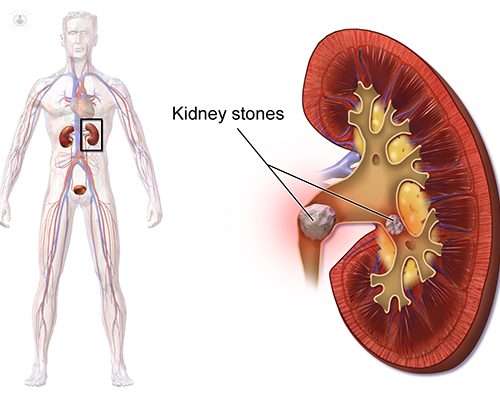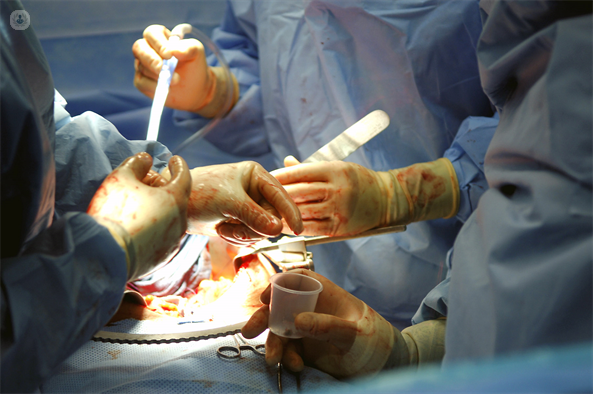Urolithiasis:causes, symptoms and treatment
Written by:
What is urolithiasis or renal lithiasis
Urolithiasis is the presence of stones (lithiasis, hard masses, "stones") in the urinary tract (kidneys, ureters and bladder) capable of causing pain, obstruction, bleeding or infection.
One or more calculations can be presented at the same time, and 4 types are distinguished according to their chemical composition:
- Calcium Calculations: are the most common, and are formed by excess calcium or oxalate in the blood. The former can appear by taking certain drugs or by excessive vitamin D, and the second by genetics or a diet with foods rich in oxalate (such as spinach).
- Uric Acid Calculations
- Cystine calculi: are rare, and occur in people with an inherited disease that causes the kidneys to excrete large amounts of certain amino acids.
- Struvite calculi: caused by bacteria that infect the urinary tract. It's more common in women.

Urolithiasis or renal lithiasis: causes
They occur inside the urinary tract, usually kidney and less frequently in the bladder and the causes for its production are multiple:
- Diets (excess calcium, protein, oxalates, obesity, deficit in fluid intake, etc.)
- Sedentary lifestyle and immobilization
- Endocrinological alterations (hyperuricemia -gota-, hyperthyroidism, hyperparathyroidism, etc.)
- Ingestion of some drugs (vitamin D and C at high doses, calcium antagonists, some diuretics, Indinavir, etc.)
- Diseases (myelomas, inflammatory bowel diseases - ulcerative colitis and Crohn's disease, sarcoidosis, etc.)
- Recurrent urinary tract infections (some bacteria are able to produce lithiasis)
- Anatomical alterations (congenital vesicoureteral refluxes, urinary tract diverticula, horseshoe kidneys, sponge kidneys, stenosis -checks-ureteral and pyeloureteral junction, etc.. Or secondary to urological surgeries)
Urolithiasis or renal stones: symptoms
They can take place without producing symptoms in a high percentage of the occasions. Sometimes, and as a result of eroding the interior of the urinary tract, they cause a darker and even bloody urine.
Other times they can cause back and abdominal pain, fever (if there is an infection), dysuria (urination) or the "dreaded" nephritic colic (very severe pain radiated from the lower back to the abdomen and often accompanied by nausea and vomiting )
Treatments for urolithiasis or renal lithiasis
The treatments are multiple and go according to the size of the lithiasis, its location, the age and associated pathology of the patient. As general preventive measures dietary measures should be considered and in some cases pharmacological or interventional treatments.

1. Dietary measures :
- Abundant intake of fluids (able to urinate above 2 liters per day)
- Avoid excess protein, foods rich in oxalate and uric acid
- Avoid excess sodium (the common salt we use at meals usually)
2. Pharmacological treatment (potassium citrate, allopurinol to lower uric acid levels, thiazides diuretic increasing calcium reabsorption, vitamin B6, antibiotics in lithiasis of infectious origin ...).
3. Interventional treatment (minimally invasive treatments are attempted whenever the case permits).
- Extracorporeal shock wave lithotripsy ; High energy waves that, applied to the body surface, focus all their energy on the stone. If lithiasis is large they are not as effective.
- Endoscopic surgery ; Fragmentation of the lithiasis) by means of laser, electro-hydraulic energy, etc.) in the interior of the organism without having to perform external wounds; Cystolithotricia, inside the bladder; Ureterorenoscopy, treatment of lithiasis inside the ureter and kidney.
- Percutaneous nephrolithotomy ; Fragmentation and treatment of lithiasis within the kidney through a minimal access in the lumbar area.
- Open surgery (for large stones or associated with anatomical abnormalities that prevent less invasive treatments).
For more information consult your urologist .


